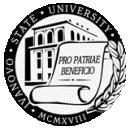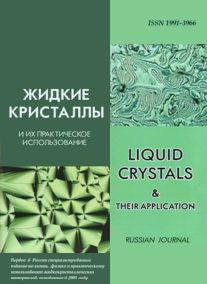|

|
Liquid Crystals and their Application
Russian Journal Zhidkie kristally i ikh prakticheskoe ispol'zovanie Жидкие кристаллы и их практическое использование |

|
|

|

|
|
|
Menu

|
|
|
|
|
Zhidk. krist. ikh prakt. ispol'z. = Liq. Cryst. and their Appl., 2019, 19 (2), 31—39.
DOI: 10.18083/LCAppl.2019.2.31 |

|
|
Polarized Luminescence of Alighned Lanthanide Containing Nematic Mixtures
|
A. A. Knyazev1, A. S. Krupin1, W. Haase2, Yu. G. Galyametdinov1,3
|
Author affiliations
1Kazan National Research Technological University,
68 Karl Marx St., Kazan, 420015, Russia
E-mail: krupin_91@mail.ru
2Institute of Physical Chemistry, Darmstadt University of Technology,
5 Karolinenplatz, Darmstadt, 64289, Germany
3Kazan E. K. Zavoisky Physical Technical Institute,
10/7 Sibirsky Tract, Kazan, 420029, Russia
|
|
Abstract
The main practical property of liquid crystals (LC) is the possibility of obtaining ordered media with a uniaxial arrangement of molecules. The introduction of lanthanide ion into liquid crystal molecule makes it possible to combine the orientational behavior of liquid crystalline mesophases with high magnetic anisotropy and luminescent properties as well as to approach the creation of multifunctional materials with unusual magnetic and optical properties. The purpose of this work was to study the possibility of obtaining high-performance fluorescent media based on lanthanidomesogens and commercial organic liquid crystals. On the basis of the liquid crystalline Eu (III) complex and the mixture of alkyloxycyanobiphenyls (5OСB, 8OСB), the compositions with wide range of nematic mesophase, including room temperature, were obtained. The europium (III) complex was introduced into the eutectic mixture of 5OCB/8OCB in amount of 1 %. The liquid crystalline, orientational, and luminescent properties of the obtained mixtures were studied. It was found that the mixture containing even 1 wt. % of europium (III) complex already exhibits intense red luminescence. Samples with the unaligned, homeotropic and planar supramolecular organization were prepared with the help of orienting liquid crystalline cells. The influence of orientation on luminescent properties was investigated. It was established that the planar alignment of the samples causes the luminescence intensity increase 1.6 times as compared with the unaligned ones. The homeotropic alignment leads to the luminescence intensity decrease by 1.2 times. Studying the polarized luminescence of lanthanide-containing nematic LCs with respect to plane-polarized excitation beam showed that the luminescence intensity of unaligned samples and the samples with homeotropic alignment does not differ when the polarizers are shifted relatively substrates by 90°. For the sample with planar alignment, a 1.2-fold change in the luminescence intensity was observed when the alignment direction changes relatively to the polarization plane of the exciting beam. Thus, it was shown that it is possible to obtain aligned lanthanide-containing LC media with controlled luminescence intensity.
Keywords: liquid crystals, europium complex, nematics, polarized luminescence
|
|
|
|
|
|




